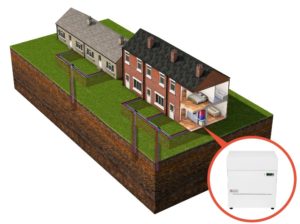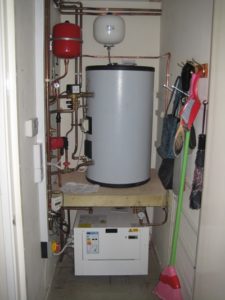Following Government legislation which has enabled new financial models, Simon Lomax, Managing Director of Kensa Heat Pumps, assess how heating demands on new developments can be met using shared ground loop arrays & split ownership.
Housebuilders may not be aware that subsidy support is available for new build residential developments. The Non Domestic Renewable Heat Incentive (RHI) provides financial support for individual ground source heat pumps installed inside each dwelling served by a shared ground loop array. This system architecture is regarded as ‘district heating’, and so both new build and retrofit installations of this nature are eligible for 20 years of Non Domestic RHI income.
The 2018 Renewable Heat Incentive (RHI) Regulations included an important refinement for ground source heat pumps (GSHPs). Along with clarification regarding split ownership arrangements (which I will touch upon later), quarterly Non Domestic RHI payments for residential properties linked to shared ground loop arrays are now based upon the deemed heat consumption taken from the Energy Performance Certificate (EPC).

Previously, RHI payments were based upon the metered heat consumption at each dwelling served by the shared ground loop. This forced system owners to install heat meters and engage in an onerous quarterly claims process, and with no certainty on the level of RHI income they would receive over the 20 year period, as usage was significantly impacted by occupant behaviour, a factor beyond their control.
Now owners of as few as two ‘clustered’ properties can invest with confidence in GSHPs connected by shared ground loops, knowing with certainty the level of income they will receive via the RHI over 20 years, and avoiding the hassle of metering. This change enables those looking to develop multiple dwellings for private sale to fund, own and maintain the ground array, recouping their investment with confidence via the RHI income.
Split ownership
The Non Domestic RHI income available for multiple dwellings linked to a shared ground loop array can be used to attract external investors to take separate ownership of the ground array asset, in the same way that the gas infrastructure is owned by entities quite distinct from the householder.
Kensa’s funded ground array mechanism leaves the developer with just the cost of the ground source heat pump units themselves
With RHI income for shared ground loop arrays now based upon the deemed heat consumption at each dwelling, funders are now encouraged to provide no-cost ground arrays: they are now certain of their income and realise the asset – the underground array – will have modest and very predictable maintenance costs.
Kensa’s funded ground array mechanism leaves the developer with just the cost of the ground source heat pump units themselves. These can be sold along with the property and the new tenants will benefit from a low carbon and low cost heating solution – a win-win for all. And, each dwelling is free to source electricity from its own preferred energy company, switching as required.

Supporting carbon compliance
Housebuilders and their SAP consultants are also realising the specification of a shared ground loop array ground source heat pump system can allow savings to be made elsewhere in the build, without compromising compliance with building regulations. The combination of carbon and running cost savings of ground source heat pumps with shared ground loop arrays has been documented within a recent report by Etude, commissioned by the Greater London Authority (GLA), ‘Low Carbon Heat: Heat Pumps In London’. The results show shared ground loop array installations, defined in the report as a ‘communal ground loop connected to individual heat pumps’, as the most efficient and lowest cost solution compared to various air source, direct electric and gas configurations, offering real opportunity and relief to many developers who are facing increasingly stringent carbon compliance targets.
Government’s ambition for the widespread electrification of heat is driving policy to deliver lower carbon developments, and with further decarbonisation of the grid, electrically delivered heat is widely regarded as the future of heating. With proposed reductions in the carbon intensity figures used within SAP, the specification of GSHP’s will simplify compliance with building regulations, and reduce carbon compliance costs.
Kensa is confident that these new financing models emerging as a result of certainty of RHI income and split ownership will encourage the widespread adoption of ground source heat pumps and shared ground loop arrays in private housing.









